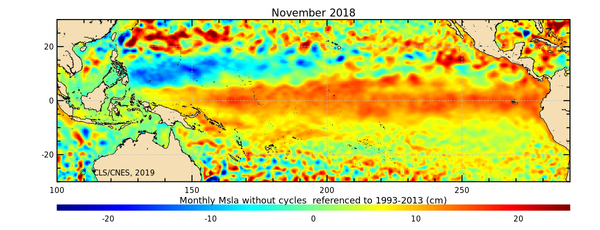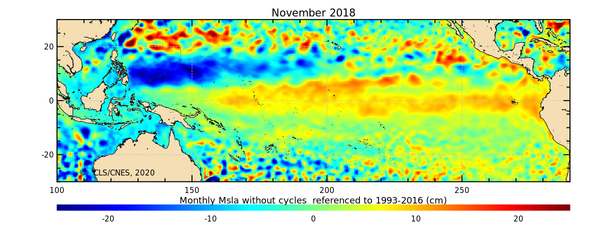January 2020: Update of the El Niño Southern Oscillation (ENSO) index
The altimeter sea level measurements are used to derive the ENSO index, which provides an estimate of the variations and intensity of this large scale phenomenon, strongly related to the ocean circulation and climate variations (see dedicated web page). In January 2020, the processing of the ENSO index has been updated so that the altimeter sea level maps are now corrected for the trend.
The ENSO index is computed with preprocessed altimeter sea level maps, which are corrected for the annual, seasonal and 60-day signals. However, the sea level maps are not corrected for the long-term trend, which directly affects the final indicator.
In January 2020, the processing of the ENSO index has been updated so that the altimeter sea level maps are now corrected for the trend in each grid point. In addition, the reference period used to estimate the periodic signals has been upgraded and changed from 1993-2013 to 1993-2016. The changes are summarized in the table below:
| Previous version | 2020 version | ||
|---|---|---|---|
| Estimations of | Annual signal |
|
|
| Seasonal signal | |||
| 60-day signal | |||
| Trend | Not removed | Removed |
Impact on the ENSO index:
The figure below illustrates the impact of these evolutions on the monthly map of sea level anomalies (November 2018) used as input for the ENSO index computation.
In the 2020 version (bottom), the sea level anomalies remain centered whereas the map became saturated in the red positive values with the previous version (top) when the trend was not removed.


The impact of the evolutions on the ENSO index timeseries is presented on the figure below with two curves corresponding to the previous (yellow curve) and 2020 (green curve) versions. The removal of the sea level trend directly affects the determination of periods related to El Niño (positive) or La Niña (negative) events.





